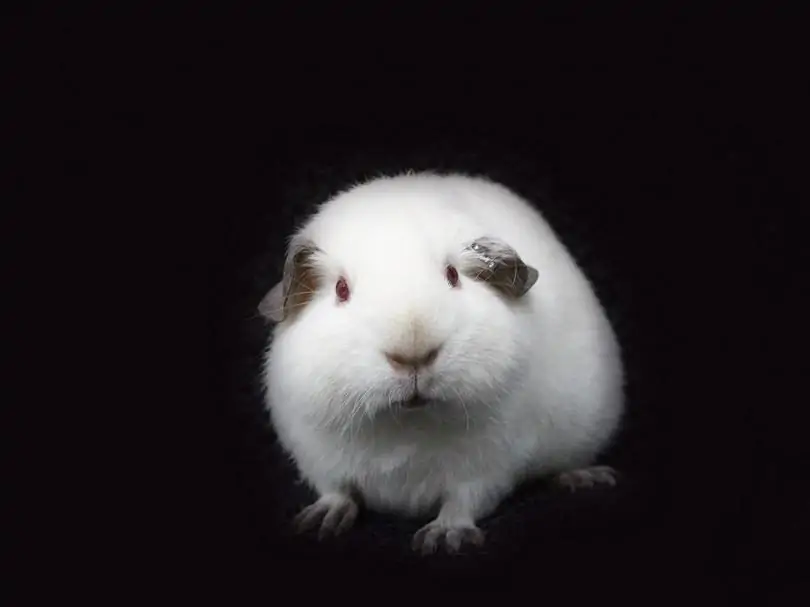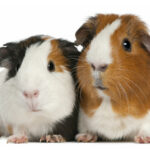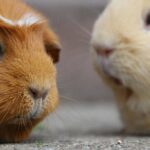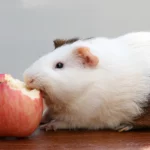The guinea pig is a popular pet. Not only are they the ideal size for youngsters, making them ideal family pets, but they also come in a range of attractive fur patterns that appeal to people of all ages.
One such fur pattern is called Himalayan, and it defines a guinea pig with a distinct coloring.
Himalayan guinea pigs are albino cavies; their fur is completely white and their eyes are crimson.
These guinea pigs are not a distinct species from other guinea pigs; rather, they are a distinct breed.
What differentiates them, though, is the black or brown fur on their forehead, ears, and feet.
Due to their identical distinguishing markings known as points, Himalayan guinea pigs are sometimes compared to Siamese cats.
What Is A Himalayan Guinea Pig
Despite the fact that dogs and cats still dominate the American pet market, many people enjoy having small rodents such as guinea pigs as companions.
It’s not too difficult to take care of these tiny creatures, and they’re a lot of fun to have around.
A variety of guinea pigs are available, the most popular of which is the American Guinea.
Now we’re going to take a look at a subspecies of guinea pigs that not many people are familiar with: the Himalayan guinea pig.
Most people assume that all guinea pig breeds are basically the same. Let’s examine a few of the Himalayan’s unique features.
Where Does The Himalayan Guinea Pig Come From?
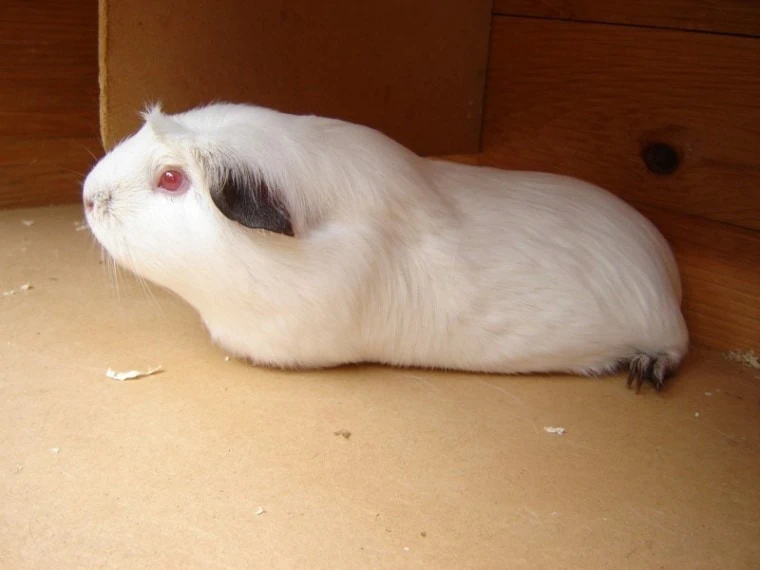
You could assume that the Himalayan guinea pig originates in southeast Asia given its name.
Like other guinea pig varieties, their ancestry can be traced back to South America.
Like a Himalayan cat, the Himalayan has distinctive markings and coloring, hence his name.
For the same reason, you might hear them referred to as “the Siamese cat of guinea pigs.”
Although Himalayan teddy guinea pigs have colored markings (called “points”), these are considered to be a result of their albino status.
They are good, social pets with a lifespan of 7 years or so.
Himalayan Guinea Pig Characteristics
Adults of this breed typically range in length from 8 to 12 inches.
One of the stockier breeds, though, Himalayans have thick bodies and broad shoulders.
Himalayans have the same mentality and temperament as any other guinea pig, in that they are incredibly affectionate and responsive to positive human interaction.
However, they have a tendency to be nervous and quickly startled, especially when in unfamiliar situations.
This means that they need places to hide within their enclosures so that they feel secure.
Because of their nature as herd animals, Himalayan pigs feel most at ease when they are in the company of another pig.
For this reason, adopting a single Himalayan guinea pig is not as good as adopting a pair.
However, keep in mind that obtaining a variety of sexes will produce a large number of very little offspring.
In that case, you might want to think about buying a pair of the same sex.
When well cared for, a Himalayan guinea pig can live for up to seven years.
Himalayan Guinea Pig Behavior and Temperament
Himalayan guinea pigs, like other guinea pigs, make great pets for people who enjoy interacting with their small animals.
It’s best to keep them in a group with other guinea pigs, but they also like lots of attention from their owners.
They respond positively to being petted, talked to, and given treats when they are accustomed to human interaction.
Like any other pet, guinea pigs can nip if they are startled, wounded, or terrified.
Size Information
A Himalayan guinea pig is about the size of a regular guinea pig.
Adult guinea pigs typically measure between 8 and 10 inches in length and weigh between 1.5 and 2.5 pounds.
They lack tails and are relatively short.
Housing
You should pay close attention to the flooring in the enclosure where you keep your Himalayan guinea pig.
If the floor of their cage is too unclean, guinea pigs risk getting their small feet stuck in the wire or developing infections and disorders like bumblefoot.
It’s best to choose a large, sturdy enclosure.
As guinea pigs do not jump or climb, the height of the cage is not as crucial as the width and depth, which should be at least 2 feet by 5 feet for two cavies.
Make sure your guinea pig can’t get its head caught in the cage’s bars or fall out.
Specific Substrate Needs
Cage bedding with dyes or newspaper ink should be avoided around white Himalayan guinea pigs to prevent accidental discoloration.
If your cavy has a sensitive respiratory system, you should also stay away from pine and cedar wood shavings.
Instead, choose dye-free paper beddings that can soak up liquids.
What Do Himalayan Guinea Pigs Eat & Drink?
As a species, guinea pigs are strictly herbivorous and consume solely plant matter in their diet.
The diet of an adult Himalayan guinea pig should consist mostly of grass hays, such as Timothy or Orchard, with guinea pig pellets, fresh vegetables, and fresh fruits added as supplements.
It is crucial to make sure your guinea pig gets enough vitamin C, so keep an eye on when the pellets expire to make sure your cavy gets the most out of them before they go bad.
Additionally, vitamin C snacks should be provided to augment this vitamin.
Vitamin C-rich foods, like bell peppers, are also acceptable to give.
Water that is safe to drink should also be available at all times.
Your pig will get part of the water it needs from the fruits and vegetables it consumes, but you should still provide it with a water bottle and a bowl of water at all times.
Frequent Medical Issues
Many other diseases and conditions, including dental issues, bladder stones, bumblefoot, lice, respiratory illness, scurvy, broken legs, ileus, diarrhea, conjunctivitis, uterine cancer, ovarian cysts, pyometra, and scurvy, can affect guinea pigs.
It’s recommended that you take your pocket pet in for annual or semiannual checkups with a vet who is experienced with treating pocket pets.
Exercise
A guinea pig’s physical and mental well-being benefits greatly from time spent out of its cage.
It’s important to give your guinea pig plenty of time to exercise in a secure environment.
Hamsters’ typical play equipment, such as wheels and balls, is not suitable for guinea pigs.
Think about getting them an X-pen so they can securely roam outside their cage.
Grooming
Due to their lack of hair, Himalayan guinea pigs require only the occasional washing of their feet and rear end, as well as the occasional bath.
Some guinea pigs may also require having their nails cut, but this is not always necessary.
Baths
When bathing your guinea pig, make sure it doesn’t get too cold or too hot.
Towel dry your cavy after a bath with lukewarm water and mild shampoo or soap (veterinarians that specialize in small mammals do not advise using dish soap, as it can be too rough on the skin).
Overheating your pig is likely if you use a hair dryer.
Upkeep Costs
Guinea pigs need new bedding changed out once a week, as well as access to plenty of hay, guinea pig-specific pellets, and even some fresh fruits and vegetables.
Feeding and cleaning a pig will likely cost you roughly $10 a week.
Examinations at the vet can cost anywhere from $50 to $80, and it’s suggested that you take your pet in at least once a year.
Extra fees may be incurred for testing and medication if your veterinarian discovers any issues during your appointment.
Pros & Cons of Keeping a Himalayan Guinea Pig as a Pet
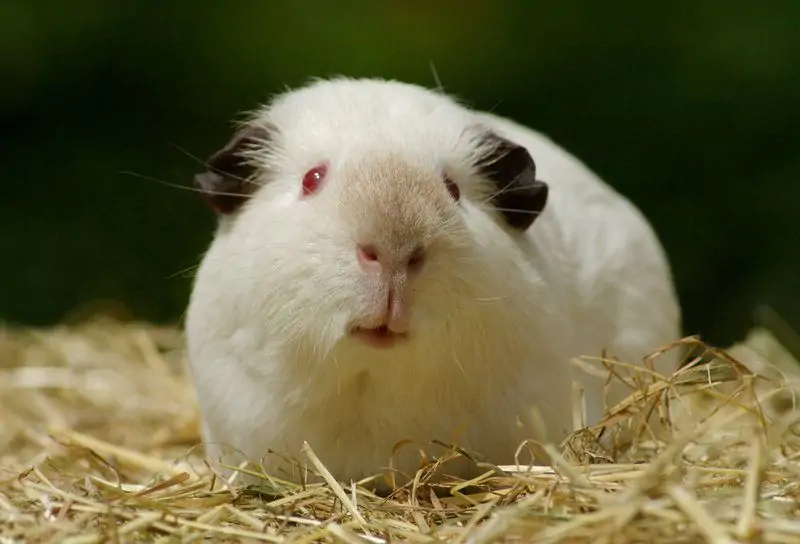
While guinea pigs aren’t the type of pet you’d take for a walk, they nevertheless enjoy human company and are fun to interact with.
They also outlive most hamsters but not as long as a dog or cat.
They demand minimal effort on your part, but also consistent attention, cleaning, and fresh food preparation.
Not as quiet as a rabbit, but also not as loud as a bird, they produce various noises.
Purchasing or Adopting Your Himalayan Guinea Pig
If you want to buy a Himalayan guinea pig, you’ll probably have to track down a breeder, as they aren’t the most common type of guinea pig.
You can find a local Himalayan guinea pig breeder through cave shows, county fairs, and cavies clubs.
Reproduction/Breeding
Unless you want to have your female cavy spayed, you should only keep female guinea pigs together, as males and females are likely to try to procreate.
Despite the fact that guinea pig mothers only have to deal with the delivery of one or two offspring, the process can be extremely traumatic.
Unless female guinea pigs are bred before their pubic symphysis fuses, a C-section will be required to preserve the mother and her young.
Do Himalayan Guinea Pigs Bite?
When they do bite, guinea pigs often don’t deliver a particularly painful blow.
Just out of curiosity, they could try to nip the person holding them. However, aggression is quite rare among them.
Even so, it’s wise to take measures to ensure your pet doesn’t experience any unnecessary anxiety.
Make sure an adult is around to oversee any kids who will be handling the guinea pig to ensure they are being kind and careful.
Himalayan Guinea Pig Life span
When properly cared for, the typical lifespan of a Himalayan Guinea Pig is between 5 and 7 years.
Despite being subject to the same health issues that plague most guinea pig breeds, they are generally healthy pets.
Do Himalayan Guinea Pigs Smell?
If guinea pigs smell bad, it’s usually because of their housing rather than the animals themselves.
To prevent them from smelling badly, guinea pigs need clean bedding, fresh food, and frequent grooming.
Keeping Himalayan Guinea Pigs Together
There’s a typical tendency for guinea pigs to be somewhat possessive of their living spaces.
It’s advised that you start with two if you’re interested in having more than one.
Whether you have a Himalayan guinea pig or another breed, introducing a new guinea pig may be a trying and stressful experience for everyone concerned.
Always acquire a large enough cage for your guinea pigs if you plan on getting more than one.
Caring For A Baby Himalayan Guinea Pig
Newborn Himalayan guinea pigs typically measure between 3 and 5 inches.
They need to be breastfed for three to six weeks, but can start eating solids as early as 24 hours old!
The babies should be with their mothers for the first three weeks of their lives.
Then, separate the sexes lest you quickly have an overpopulation problem on your hands.
If you can find a local breeder of Himalayan guinea pigs to purchase a baby from, make sure to question the breeder about their expertise in breeding the species, the health of the parents, and whether or not the breeder performed any sort of health checks on the animals.
Many illnesses can affect guinea pigs, and it might be tough to foresee which ones will appear.
The health of the animal depends on the breeder’s attention to detail during the breeding process.
